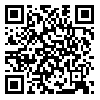Volume 6, Issue 1 (Continuously Updated 2023)
Func Disabil J 2023, 6(1): 0-0 |
Back to browse issues page
1- Rehabilitation Research Center, Department of Audiology, School of Rehabilitation Sciences, Iran University of Medical Sciences (IUMS), Tehran, Iran.
2- School of Medicine, Iran University of Medical Sciences, Tehran, Iran.
3- Rehabilitation Research Center, Department of Basic Sciences in Rehabilitation, School of Rehabilitation Sciences, Iran University of Medical Sciences, Tehran, Iran. ,vasaghi.b@iums.ac.ir
2- School of Medicine, Iran University of Medical Sciences, Tehran, Iran.
3- Rehabilitation Research Center, Department of Basic Sciences in Rehabilitation, School of Rehabilitation Sciences, Iran University of Medical Sciences, Tehran, Iran. ,
Abstract: (514 Views)
Background and Objectives: One of the major problems of today’s industrial life is the injuries and abnormalities caused by improper use of equipment in the neck muscles and spine. One of these injuries is forward head posture (FHP). The present study was conducted to investigate the effect of the presence of FHP and its severity on the students’ hearing thresholds.
Methods: In this cross-sectional study, 55 volunteer students participated. All subjects completed a questionnaire containing general questions and specialized questions in the field of hearing risk factors. Side-view pictures were taken of each person. After selecting three photos, the size of the craniovertebral angle was determined using the MB Ruler software. The mean of the three sizes obtained was used in statistical analysis. Audiometry and tympanometry were performed.
Results: Out of 31 women and 24 men, 24 women (77.41%) and 21 men (87.5%) had FHP. In women, the number of severe FHP was twice that of men. No statistically significant difference was observed between men and women suffering from FHP alone and according to its classification. In this study, no statistically significant difference was observed between FHP and its classification with hearing thresholds.
Conclusion: In this study, most students had FHP (81.8%). Considering that the volunteers are students and are faced with the factors affecting the occurrence of FHP, the existence of a large number of students with this condition is not surprising, and it can be concluded that this condition does not affect the young students’ hearing.
Methods: In this cross-sectional study, 55 volunteer students participated. All subjects completed a questionnaire containing general questions and specialized questions in the field of hearing risk factors. Side-view pictures were taken of each person. After selecting three photos, the size of the craniovertebral angle was determined using the MB Ruler software. The mean of the three sizes obtained was used in statistical analysis. Audiometry and tympanometry were performed.
Results: Out of 31 women and 24 men, 24 women (77.41%) and 21 men (87.5%) had FHP. In women, the number of severe FHP was twice that of men. No statistically significant difference was observed between men and women suffering from FHP alone and according to its classification. In this study, no statistically significant difference was observed between FHP and its classification with hearing thresholds.
Conclusion: In this study, most students had FHP (81.8%). Considering that the volunteers are students and are faced with the factors affecting the occurrence of FHP, the existence of a large number of students with this condition is not surprising, and it can be concluded that this condition does not affect the young students’ hearing.
Article number: 231.2
Type of Study: Research |
Subject:
Audiology
Received: 2023/04/10 | Accepted: 2023/07/2 | Published: 2023/02/6
Received: 2023/04/10 | Accepted: 2023/07/2 | Published: 2023/02/6
| Rights and permissions | |
 |
This work is licensed under a Creative Commons Attribution-NonCommercial 4.0 International License. |





